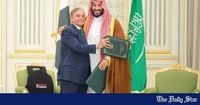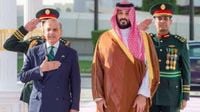In a move that has sent ripples through diplomatic circles from Washington to New Delhi, Pakistan and Saudi Arabia have sealed a landmark mutual defense pact—one that, according to multiple analysts, may include nuclear guarantees for the Kingdom. The agreement, formally announced this week, represents a major pivot in the security architecture of both the Middle East and South Asia, binding the two nations to come to each other’s aid in the event of military aggression. The implications, as experts and officials scramble to interpret the fine print, are as far-reaching as they are controversial.
Saudi analyst Ali Shihabi, known for his close ties to the royal court, told AFP bluntly that the pact does, in fact, cover nuclear sharing. “Yes, it does,” he stated, pointing to the Kingdom’s long-standing financial support for Pakistan’s nuclear program during the years when Islamabad was under heavy international sanctions. This assertion, while not officially confirmed by either government, has fueled intense debate among regional and global observers, especially as the prospect of a Saudi nuclear umbrella has previously been a closely guarded secret.
The timing of the agreement is no coincidence. As reported by Daily Times, Riyadh’s push for external security guarantees comes after its failed attempts to secure similar commitments from Washington. The Biden administration, seeking to coax Saudi recognition of Israel under the Abraham Accords, had floated the idea of a formal U.S.–Saudi mutual defense agreement. But Israel’s ongoing military campaign in Gaza and its rejection of a two-state solution effectively buried that prospect, leaving the Saudis searching for alternatives.
Enter Pakistan. For decades, the two countries have cooperated quietly on security matters, with Saudi Arabia acting as a patron during Islamabad’s lean years. This new pact, however, takes things “a step further by formally and explicitly binding their security to one another, declaring that ‘any aggression against either country shall be considered an aggression against both,’” as a detailed analysis published on September 24, 2025, explained. For Saudi Arabia, the deal offers a firmer external guarantee in a region where Israeli assertiveness, Iranian ambitions, and Houthi threats have all collided with the Kingdom’s rising economic stakes. For Pakistan, the agreement both revives a historic partnership and elevates its own geopolitical profile, especially at a time of heightened tension with India.
What’s changed? According to Daily Times, the pact signals a shift away from Pakistan’s traditional nuclear ambiguity. With Israel’s hardline government under Benjamin Netanyahu issuing open threats and India adopting a more aggressive posture, both Islamabad and Riyadh are seen as drawing clear red lines in the sand. The mutual defense clause, while reminiscent of NATO’s Article 5, is particularly significant in a region where alliances have often been informal and ambiguous.
Not everyone is cheering. Critics worry that the agreement could drag Pakistan into Saudi-Iranian tensions, potentially destabilizing an already volatile region. Yet, as experts point out, changing regional dynamics may actually lower the risk of a direct clash. Israel’s hostility has, somewhat paradoxically, nudged Tehran closer to valuing unity within the Muslim world, making a direct confrontation between Iran and Saudi Arabia less likely for now.
In practical terms, the pact doesn’t mean Pakistani troops will be marching into the Arabian Peninsula or Saudi forces landing in South Asia. As observers note, in the event of a conflict with India, Pakistan is unlikely to require Saudi boots on the ground. What would matter more is steady Saudi material and financial support—a continuation of the decades-old brotherhood between the two nations.
The reaction in Islamabad has been strikingly unified. The Daily Times reports rare bipartisan support for the pact, with the PTI and other political forces describing the agreement as “vital for national security” and a reaffirmation of the long-standing bond between Islamabad and Riyadh. This unity is notable in a country often riven by political strife, underscoring just how significant the pact is perceived to be.
Internationally, the deal has sparked questions about its impact on U.S. interests. Some in Washington may see the pact as a sign of Saudi doubts about American reliability, especially given recent gaps in U.S. security provision in the region. However, as the September 24 analysis argues, this interpretation may be overstated. The agreement is less a rejection of U.S. security guarantees than a pragmatic move by Riyadh to share risk and reduce dependence on Washington. In fact, it represents the kind of “buck-passing” that could allow the U.S. to shed some of its burdens as the Gulf’s default security guarantor.
For decades, American troops and assets have protected Gulf shipping lanes and Saudi critical infrastructure, intervening whenever crises erupted. But with the U.S. facing greater entrapment risks due to Israeli military activity and its own domestic political fatigue with Middle East commitments, the Saudi-Pakistan pact injects a measure of stability into two volatile regions—without requiring new U.S. deployments.
The nuclear question, of course, looms large. For years, it has been assumed that Pakistani nuclear capabilities were at least indirectly available to Saudi Arabia. This pact, analysts say, formalizes the symbolism of a Pakistani nuclear umbrella for the Kingdom, though the details remain deliberately ambiguous. “The more destabilizing concern for both the United States and Israel has always been different: the risk of Pakistani technology transfer to Iran,” the analysis notes, referencing the A.Q. Khan network’s nuclear trafficking in the 1990s. Here, the pact may actually mitigate the danger, binding Islamabad’s interests more closely to Riyadh and raising the costs of any cooperation with Tehran.
Still, the practicalities of a nuclear guarantee remain murky. As things stand, Pakistan’s missile capabilities just suffice to threaten areas beyond Saudi territory when launched from home soil. If the pact leads to the deployment of longer-range systems or the basing of Pakistani assets in Saudi Arabia, it would certainly raise alarms in Washington and Tel Aviv. Yet, as analysts point out, this is not a foregone conclusion. Pakistan’s military leadership is acutely aware of American concerns, and Riyadh does not face existential threats comparable to those confronting U.S. allies like South Korea or Japan.
For India, the new alignment means recalibrating its diplomatic and strategic approach. New Delhi has deep economic interests in Saudi Arabia, including a vast diaspora, and is unlikely to jeopardize those ties by aggressively countering the Saudi-Pakistan nexus. Some may be tempted to pursue closer cooperation with Israel, but Israel’s own desire for eventual normalization with Saudi Arabia makes hard balancing unlikely. Instead, India is expected to pursue a “wedge strategy,” seeking to manage the new alignment without direct confrontation—a delicate dance in a shifting regional landscape.
China and Russia, meanwhile, have been expanding their influence in Riyadh, and Pakistan’s dependence on Beijing in the security domain has grown. Yet, as the analysis notes, the pact allows Saudi Arabia and Pakistan to reinforce each other’s security without moving further into either Beijing’s or Moscow’s orbit. For Washington, tolerating this arrangement may help regional actors hedge against China and Russia, all while reducing America’s own commitments.
At the end of the day, the Saudi-Pakistan defense pact is about two regional powers taking charge of their own security, rather than drawing the U.S. deeper into the region’s endless crises. Whether this new architecture will bring lasting stability or simply set the stage for new rivalries remains to be seen. One thing is certain: the rules of the game in the Middle East and South Asia have changed, and the world is watching closely.

